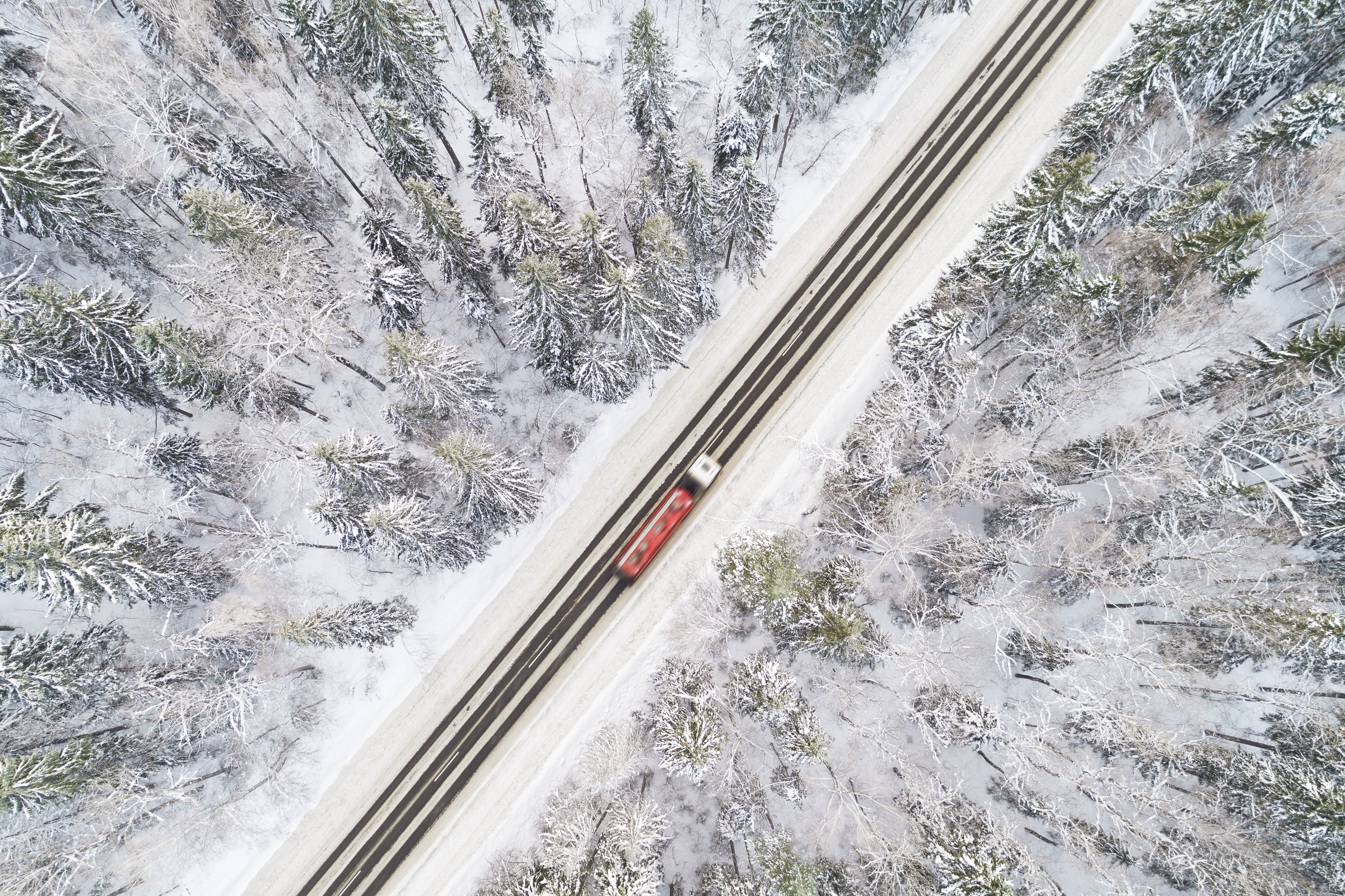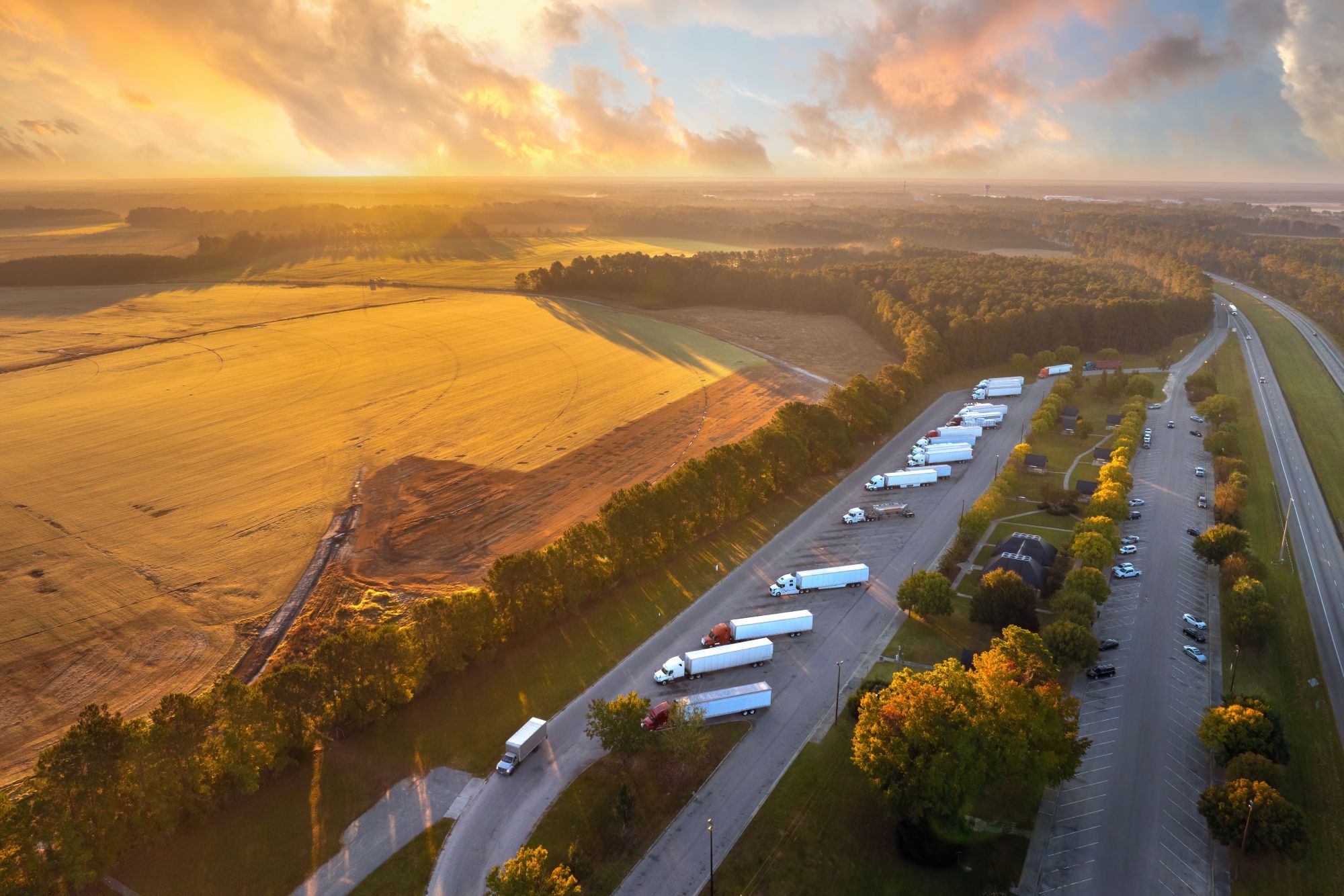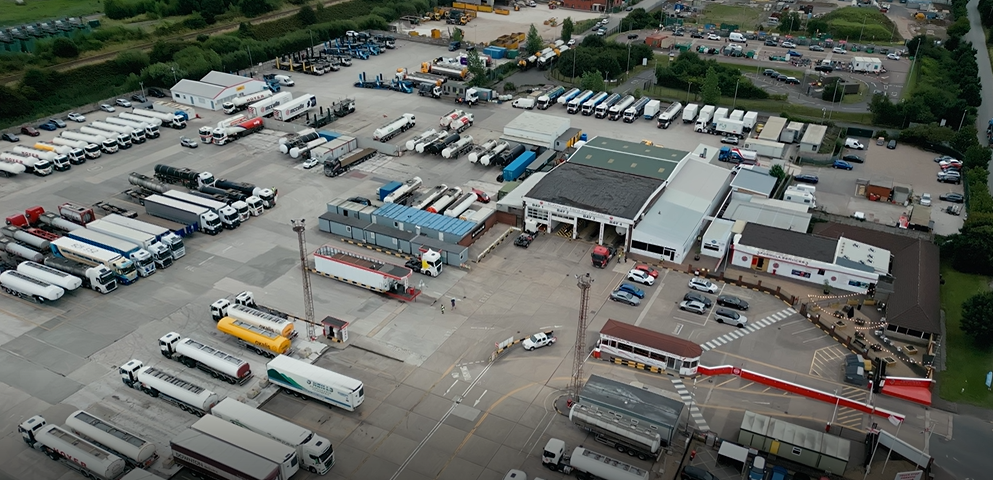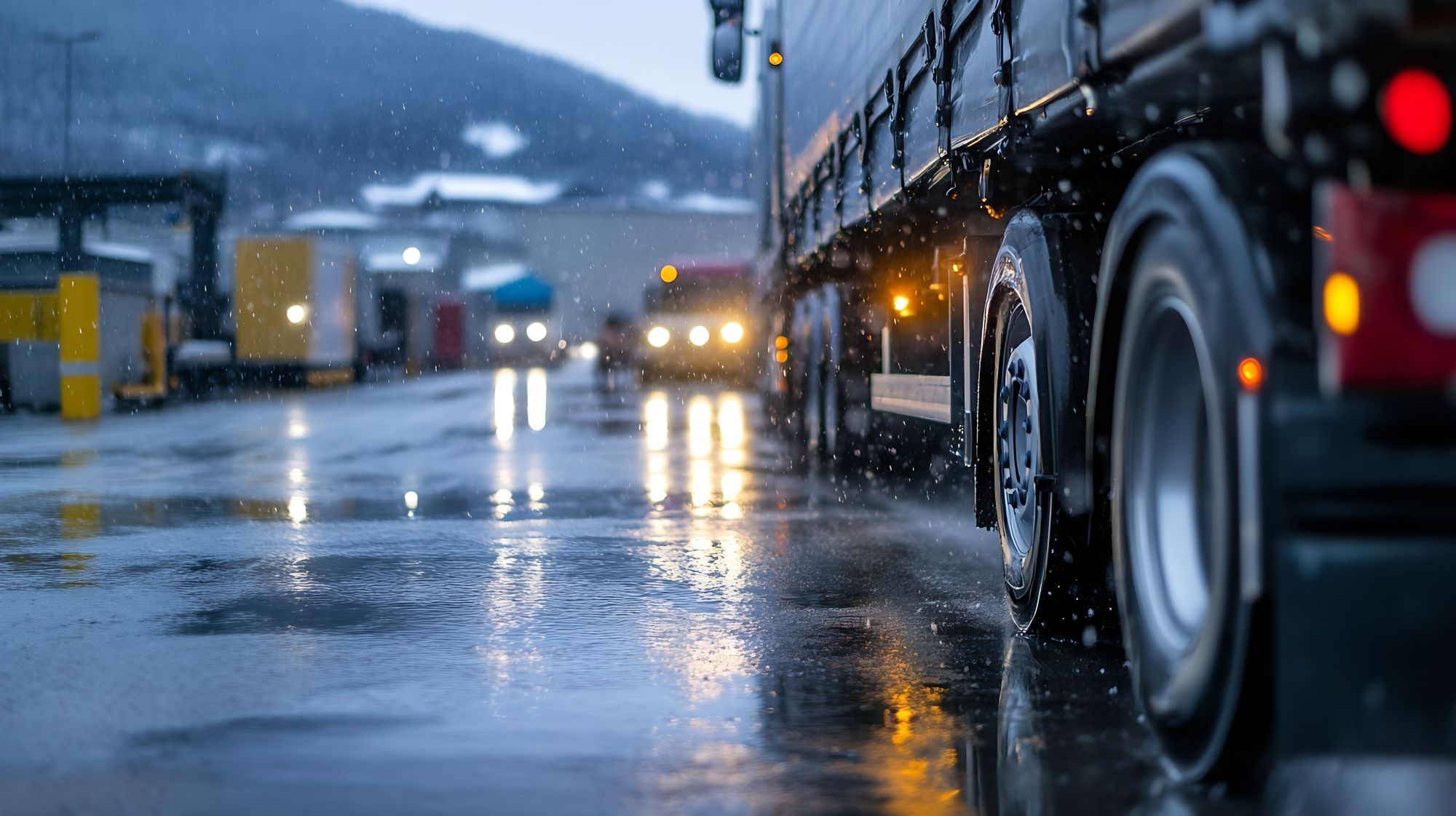
Miranda Blake
Ghidul unui șofer de camion pentru iarna în Europa
Creat: 16.10.2024
•
Actualizat: 15.09.2025
Șoferii de camioane se confruntă cu un set unic de provocări și responsabilități în sezonul rece. Se înregistrează o creștere a numărului de accidente rutiere grave, [33% din cererile de despăgubire depuse în această perioadă fiind considerate grave] (https://atha.co.uk/news/why-you-are-more-likely-to-have-a-severe-road-traffic-accident-in-the-winter).
Așadar, pregătirea este crucială. Aici, vă prezentăm modul în care șoferii de camioane pot rămâne în siguranță atât pe șosea, cât și în cabina lor în această iarnă.
Navigarea în condiții de furtună
Este esențial să conduceți încet și să păstrați o distanță de siguranță față de alte vehicule - în special în zonele inundate. Trebuie să introduceți o viteză mică și să mențineți motorul turat.
Următoarele sfaturi vă vor ajuta și la condusul pe vreme de furtună.
- Dacă pierdeți controlul pe suprafața apei, încetiniți lăsând piciorul pe accelerație - nu încercați să frânați sau să virați brusc.
- Vehiculele mai înalte sunt mai vulnerabile la vânturile intense - asigurați-vă că țineți bine volanul și evitați podurile pe cât posibil.
- Dacă autocamionul dvs. este gol, călătoriți cu părțile laterale ale cortinei deschise. În acest fel, există mai puține lucruri care pot fi prinse de vânt.
Gestionarea zăpezii și a gheții
Mergeți într-un ritm redus și păstrați distanța necesară față de vehiculul din față atunci când există gheață și zăpadă. De fapt, se recomandă să măriți distanța de frânare la de 10 ori mai mult decât în mod normal - cu toate acestea, poate fi dificil să evaluați acest lucru. Un studiu Admiral a arătat că [gheața neagră provoacă 10% din accidente în timpul iernii] (https://atha.co.uk/news/why-you-are-more-likely-to-have-a-severe-road-traffic-accident-in-the-winter). Vă puteți da seama dacă conduceți pe gheață neagră dacă drumul pare umed, dar nu există stropi proveniți de la alte vehicule.
Alte sfaturi pentru a vă ajuta să conduceți pe zăpadă includ efectuarea de inspecții periodice ale autocamionului și asigurarea că aveți toate echipamentele necesare înainte de călătorie, cum ar fi cabluri de pornire și unelte de degivrare. În plus, fiți întotdeauna conștient de treapta de viteză pe care ar trebui să o folosiți, deoarece aceasta vă poate salva de la pierderea controlului autocamionului. Pe suprafețe plane, conduceți în cea mai mare viteză posibilă. La coborâre, utilizați frâna de motor și mergeți în trepte mici. Pentru a evita patinarea roților, utilizați o treaptă de viteză mai mare atunci când demarați - acest lucru vă va oferi tracțiunea necesară pentru a mișca vehiculul.

Asigurarea vizibilității
Având în vedere că autostrăzile periculoase și factorii externi au un impact negativ asupra vederii și cauzează accidente de camion, vizibilitatea este crucială pe orice vreme, mai ales când este mai rece. Așadar, asigurați-vă că verificați dacă parbrizul prezintă cioburi sau crăpături, deoarece acestea se pot răspândi mai repede în lunile mai reci.
În plus, veți dori un nivel cât mai ridicat de vizibilitate pentru faruri, plăcuța de înmatriculare și parbriz. Pe lângă curățarea zăpezii sau a murdăriei, este indicat să vă spălați în mod regulat vehiculul pentru a evita acumularea de sare de pe șosea (care declanșează coroziunea).
Dacă vizibilitatea este redusă și condițiile devin perfide, atunci cel mai bine este să ieșiți de pe drum și să vă odihniți la cea mai apropiată stație de camioane. Dacă ajungeți să fiți nevoit să vă depășiți [orele de conducere] (https://snapacc.com/newsroom/discover-the-new-drivers-hours-rules/), atunci puteți utiliza o derogare specială pentru șoferii care sunt blocați în circumstanțe unice, cum ar fi fenomenele meteorologice extreme.
Evaluarea adâncimii benzii de rulare a anvelopei
Temperaturile scăzute pot afecta, de asemenea, funcționalitatea anvelopelor dvs., deoarece pot declanșa o presiune redusă a aerului. Din păcate, anvelopele uzate vă măresc distanța de frânare și vă reduc nivelul de stabilitate pe drumurile umede și înghețate, iar banda de rulare redusă va provoca alunecarea.
Prin urmare, este o idee bună să verificați adâncimea benzii de rulare înainte de fiecare călătorie în condiții de furtună și alte condiții dificile - în acest fel, veți ști când trebuie să rezolvați orice problemă care apare.
Respectarea reglementărilor privind anvelopele de iarnă
De asemenea, este esențial să cunoașteți diferitele reglementări privind anvelopele de iarnă. Unele țări obligă șoferii să aibă la ei saci de nisip și lopeți, în timp ce lanțurile de zăpadă sunt obligatorii în altele. Continental a compilat un [ghid simplu privind cerințele pentru anvelopele de iarnă] (https://www.continental-tyres.co.uk/b2c/tyre-knowledge/winter-tyre-laws/) pentru Regatul Unit și Europa.
De la 1 noiembrie, anvelopele de iarnă sunt obligatorii în:
- Austria
- Republica Cehă
- Finlanda Finlanda * Franța
- Lituania
- Serbia
În alte țări, acestea sunt obligatorii mai târziu în lună sau în decembrie sau depind de condițiile meteorologice. În ceea ce privește anvelopele cu crampoane, deși acestea sunt permise în țările de mai jos, există reguli stricte în ceea ce le privește. Cel mai bine este să verificați reglementările pentru fiecare țară înainte de călătorie.
- Austria
- Belarus
- Danemarca
- Estonia
- Finlanda
- Franța
- Marea Britanie
- Letonia
- Liechtenstein
- Lituania
- Norvegia
- Spania
- Suedia
- Elveția
- Turcia
- Ucraina
Aducerea de consumabile relevante
De asemenea, va trebui să vă gândiți la modul în care puteți avea grijă de dvs. în timpul iernii. Acest lucru va părea evident, dar asigurați-vă că aveți acces la suficientă mâncare și băutură. Având în vedere șansele crescute de închidere a drumurilor în sezoanele reci, este posibil să nu puteți ajunge întotdeauna la o stație de camioane. Veniți pregătit cu opțiuni de gustări sau mese, împreună cu o băutură caldă, în mod ideal, într-o sticluță.
Mai ales dacă nu aveți acces la un loc de odihnă, asigurați-vă că vă puteți încălzi. De exemplu, luați cu dvs. pachete de încălzire reîncărcabile. De asemenea, aveți întotdeauna la îndemână haine călduroase și de rezervă; acest lucru va fi deosebit de util în cazul în care hainele se răcesc și se udă în timpul unor activități precum îndepărtarea zăpezii de pe parbriz.
Ideal ar fi să aveți o trusă de supraviețuire pe timp de iarnă - constând în alimente, băuturi, un încărcător portabil de telefon, o lanternă, pături, o vestă cu vizibilitate ridicată, o lopată și încălțăminte durabilă.
Garantarea accesului la stațiile de odihnă cu intruck
Deși vremea nu depinde de dvs., vă puteți proteja pe dvs. și pe ceilalți pe șosea. Acest lucru presupune să vă asigurați că aveți un loc de parcare sigur și securizat cât mai curând posibil. Aplicația noastră intruck sau [maps page] (https://snapacc.com/map/) vă va indica furnizorii de servicii din apropiere, împreună cu informații despre facilitățile oferite de fiecare.
Puteți descărca aplicația intruck astăzi făcând clic pe [acest link] (https://intruckapp.com/download/).



